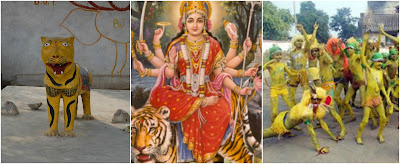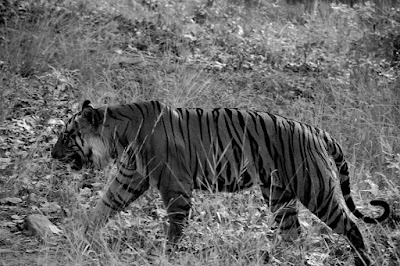Nature worship has always been an important part of Indian culture. With 'Peepul' trees being worshipped as the epicenter for learning and knowledge, they are also regarded as the abode of the god ' bada dev' worshipped by certain tribals in Central India. However the most important instance of animals in Indian religion, more specifically, Hinduism has been the role of animals as the 'vahans' or vehicles of the Indian gods and goddesses. While the reason for why the concerned animal is associated with the particular god/ goddess may not be always known, some of them have beautiful logic to them.
For example, the Goddess Durga also known as 'shakti' is associated with the tiger or lion ( the cat species varies according to region) as the big cat epitomises strength, power and a protector against all evil. Which is where the concept of 'baghesur' or the tiger god also comes up. Wherein a lot of villages worship the cat in form of a tiger/ lion to protect them from all evil and hence the goddess is celebrated along with the cat.
 |
L- R : A tiger temple at Bandhavgarh, Goddess Durga,Photo credit: www.namaha.wordpress.com,Tiger dancers celebrate Muharram
Another Goddess who forms an important part of Hinduism is Goddess Saraswati who is more famously found in educational institutions as she is associated with education, learning, music, purity and beauty. Which could also be the reason, why she is associated with two beautiful birds, namely the swan and the peacock. In some regions, the swan is replaced by a Heron or 'bagula'. Purity in form of the swan and beauty in form of the peacock. In central India, the Peacock feather is also considered very holy and any fallen feather also known as 'vidya' is collected by the students to keep in their books to help them learn better. Saraswati's depiction as riding a Peacock also translates as taking control over arrogance and not giving precedence to materialistic beauty. |
 |
Goddess Sarawati. Photo credit: www.pintrest.com, www.rexburgyoga.com
Moving from terrestial to the more acquatic, two important gods associated with the 'makara' are the Goddess Ganga and lord Varuna, the god of seas and oceans. Not entirely a crocodile, the makara is said to be half crocodile and half elephant, with some statues even depicting a trunk on the head of the crocodile. The crocodile is associated with water gods as it is said to be the protector of the waters and keeps the water clean of any contamination. At times, however,there is a debate on the mount of the goddess Ganga as the Dolphin. This association of the Goddess with the Dolphin is owing to the fact that the river Ganga is supposed to be a happy, fast flowing river, thereby reflecting the traits of the Dolphin who is a fast swimming mammal.
God of the seas and oceans, varuna, photo credit: www.pintrest.com, goddess Ganga, photo credit: www.www.imgrum.net .jpg
|
Taking a more aerial route, we come to the goddess Lakshmi who is associated with the owl, more specifically the white owl which people believe to be the Barn owl. According to some beliefs, the Owl is her sister Alakshmi who is often said to accompany the goddess of wealth, but if logic intervenes, she is associated with the owl because owls feed on rats, keeping their population under control and thereby protecting farms and crops which aid in yielding a good harvest which in turn brings wealth to the owner. Since Lakhsmi is the goddess of wealth and fortune she is celebrated with the owl. However, a sad turn to this belief is that a good number of owls are caught and sacrificed during Diwali owing to the belief that it will bring people wealth and prosperity.
 |
Goddess Lakshmi. Photo credit: www.dollsofindia.com
Said to be the river of turtles, the river Yamuna is said to be the best place to sight turtles even today, especially in a place called Bateshwar in Uttar Pradesh which is said to be a safe haven for the shelled beauties. This healthy population in the waters of this beautiful river could be one of the reasons why the Goddess Yamuna has been depicted as riding a turtle. In fact, despite its over polluted state, in some parts,Yamuna has been considered a sanctuary for fauna such as dolphins and Gharials.
 |
| Goddess Yamuna with her turtle mount. Photo credit:www.pintrest.com |
|
Labelled as the king of birds by lord Vishnu himself, the identity of Garuda who is depicted as half bird half human, as an eagle or Bhraminy Kite has often been debated. Said to be the ultimate creature of perseverance and determination, there couldn't be a better mount for the lord of preservation. It is said that,Garuda's only demand as Vishnu's mount was to be able to feed on snakes and is till date considered a sworn enemy of the 'nagas'. Perhaps it is Garuda's gastronomical love for snakes that has led many of the modern day birds much like the Crested Serpent Eagle to feed on the slithering beauties!
 |
| Vishnu on his mount Garuda. Photo credit: www.worldtechfun.com |
Loved by all, lord Ganesh is associated with the most unlikely of mounts - the rat. Leading to debates of no one is small enough to deal with issues larger than oneself, the rat or the shrew( depictions again vary according to the region) represents someone who is determined enough to carry the weight of anything larger than itself and should not be considered weak or an unlikely candidate to bear the magnitude of the problem. Another reason for the rat to be the 'vighnaharta's' (remover of obstacles) mount is that the rat can go through any small space or hole which helps the lord in question reach out to any obstacle and eliminate it owing to the flexibility of his mount.
 |
| Lord Ganesh on his mount. Photo credit: www.wikipedia.com |
From the most loved to the most feared, lord Yama is popularly known as the god of death. Often associated with the Gaur or the Water Buffalo (varies according to region), the animal is so associated with the God,so as to depict the strength which upholds actions or 'dharma' and justice where it is needed. Lord Yama is said to be the most justice of the divine forces in Hindu mythology.
 |
| Lord Yama on his mount. Photo credit: www.pintrest.com |
Apart from animals being recognised as mounts or 'vahans' of the gods, goddesses in Hinduism, animals have also played an important role as protectors to humankind, whether it was in form of Narsimha the Lion who eliminated an evil thought or king, to Jatayu the vulture who died fighting a wrong deed to Jambavan the Bear who was said to be very knowledgeable, to the three 'avtars' of Vishnu as a Wild Boar, Fish and Turtle which are said to have protected the Earth and all those living within.
Thus, it often brings to mind that we have much to learn from our mythology that gave such importance to trees and fauna existing in our forests, always accompanied with a certain message. So why can't we with these similar principles learn to appreciate those we can learn much from?











Comments
Post a Comment